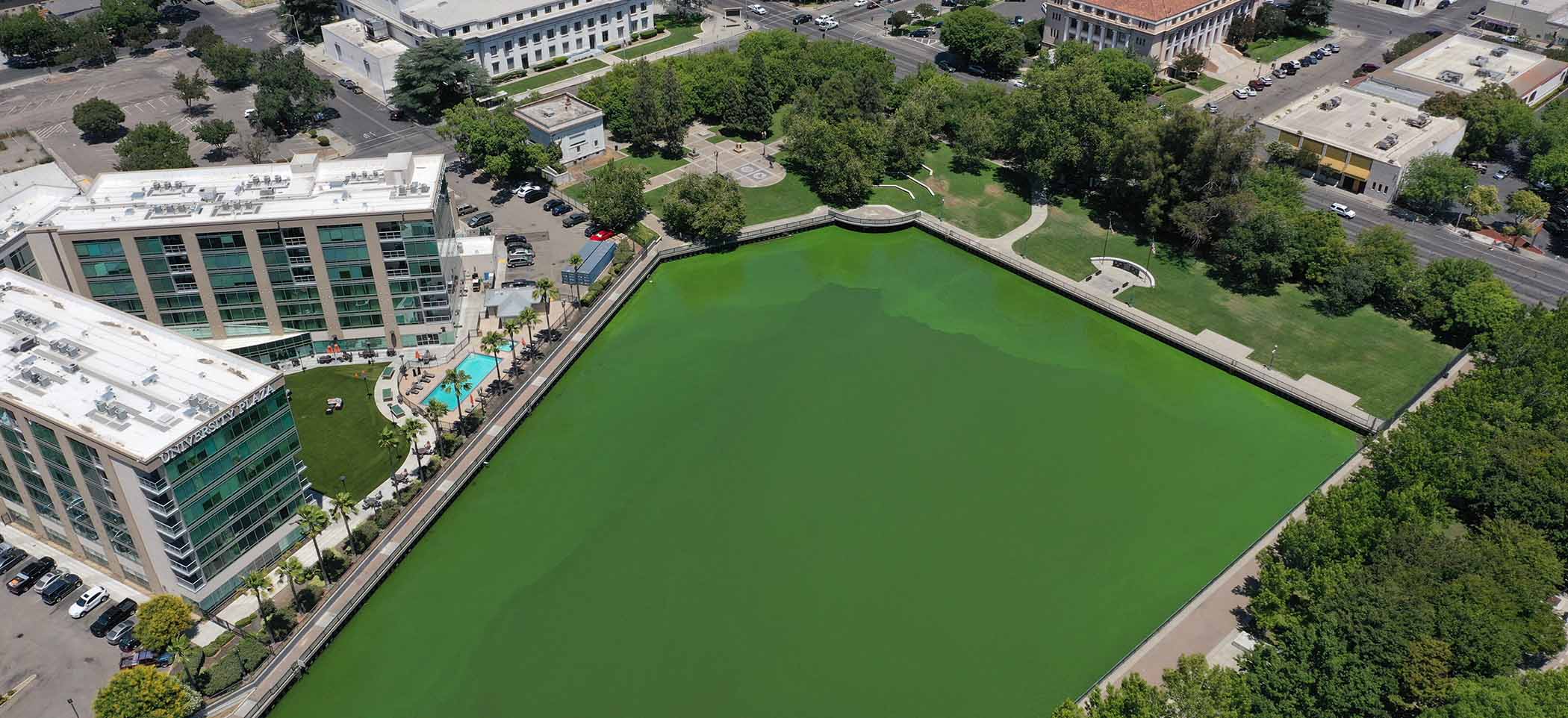
By Joe Ilick from the Dolphin Club Log
From slate gray to earthy green to sky blue, the Bay comes in many colors. Its waters are constantly, beautifully, in flux.
But the color of the Bay may not be so pretty in the years ahead. Worrying developments this summer in the Delta foreshadow what may come to pass along San Francisco’s waterfront, as outbreaks of toxic blue-green algae become larger and more numerous. San Francisco’s water use—both how much it takes from mountain rivers and how it discharges wastewater into the Bay—fosters blooms in the Delta and threatens to make them more common in the Bay itself.
As mentioned in the last edition of The Log, San Francisco and agricultural water districts take most of the Tuolumne River’s flow—about 80 percent in an average year and upwards of 90 percent in drier years. This means little water is left over to flow into the San Joaquin River, which the Tuolumne feeds into, and then into the Delta and Bay.
As a result, flows into the Delta are often reduced to a stagnant, contaminated dribble, and create conditions that promote toxic algal blooms. For the past several years, Stockton and Discovery Bay have endured sickly green waters for months at a time. Fish, wildlife, and even the family dog can be killed by toxins that emanate from these “harmful algae blooms” (HABs), and people can be sickened, too. There’s additional risk when the HABs toxins become airborne.
So what does this have to do with the Bay? For one, it’s important to remember that the Bay is not a closed system. The toxic baggage generated upstream is carried by water travelling from the Sierra to the Golden Gate. Algal toxins traced to the Delta have already been detected in Bay shellfish.
Even more worrying, conditions in the Bay itself are becoming increasingly conducive to HABs. High levels of nitrogen and phosphorus found in HABs elsewhere around the world have turned lakes and estuaries the color of pea soup. Some of those water bodies have lower levels of nitrogen and phosphorus than is currently measured in the Bay, and waters warmed by climate change only amplify the threat.
“The City of San Francisco is putting the Bay at risk because of its shortsighted water policies,” said Baykeeper scientist Ian Wren. “We’re taking too much water from the Tuolumne, and then we only use it once before flushing it and a heavy load of nutrients into the Bay.”
There’s no question that the spread of toxic algae in the Bay would be devastating for swimmers and boaters—not to mention any human or animal that spends time on or near the water. But there’s a fairly straightforward solution to addressing HABs that currently dominate the Delta as well as those that could, in the future, turn San Francisco Bay green. Water recycling—treating and purifying wastewater so it can be re-used—reduces demand for water diverted from Bay tributaries, while simultaneously reducing the nitrogen and phosphorous that is released into the Bay.
Other cities in the western U.S. have learned the lessons of repeated droughts and are recycling water to reduce their burden on rivers, while increasing the reliability of their supply. For instance, Orange County is a global leader in using advanced wastewater treatment for potable reuse. In the Las Vegas area, recycled wastewater goes to irrigate parks and golf courses, although most is filtered through wetlands and returned into Lake Mead. San Diego is currently implementing a wastewater recycling project that will provide more than 40 percent of the city’s water supply locally by the end of 2035.
But SFPUC lags behind. Unlike its southern California peers, San Francisco currently has no plans to make recycled water widely available in the next 25 years.
“San Francisco is facing both a challenge and an opportunity,” said Wren. “The science tells us SFPUC’s current water diversions and wastewater discharges are unsustainable. If the city fails to plan now, it could mean disaster for the Bay, as well as its flora and fauna and the fishing and recreation industries that depend on it. By recycling its wastewater, the city can take less from our Sierra rivers and keep the Bay blue.”
It would be a terrible tragedy if San Franciscans only wake up to this connection—and to the City’s shortsightedness—when the Bay turns a poisonous pea green. Like wildfires and their ominous orange skies, this toxic green brew will become a new horrific seasonal tradition if things don’t change soon.
Pictured: Stockton in the midst of an algal bloom in the summer of 2021. Photo by Baykeeper.